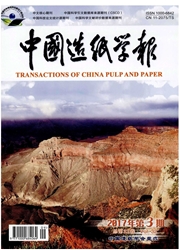

 中文摘要:
中文摘要:
以漂白KP桉木浆中的原生细小纤维(P200)和长纤维(R30)打浆剥落的细小纤维碎片(P'200)为研究对象,发现它们在物理形态与表面化学性能方面存在明显差异。研究结果表明:细小纤维中戊聚糖含量P200为26.16%,P'200为20.06%;羧基含量P200为6,386mol/100g绝干浆,P’200为5-484mol/100g绝干浆;灰分含量P200是P’200的3.6倍;比表面积‰为14.36m^2/g绝干浆,P'为91.66m^2/g绝干浆。细小纤维比原浆有更大的保水值,且细小纤维的保水值随着系统pH值的升高而增大;P'200比P200吸附有更多的水和更高的阳离子需求量。纸浆系统电导率的升高对P200的保水值基本上没有影响,对原浆和P’200的水化程度有一定的压缩作用,且都呈缓慢下降趋势。
 英文摘要:
英文摘要:
In this paper, both the original fines (P200) of BEKP and the fragment (P'200) of its long fihers (R30) which came from beating process were studied. There were some differences in their morphology and surface chemical characteristics. It was shown that the pentosan content of P200 is 26.16%, P'2oo only 20.06%. The contents of carboxyl are 6. 386mrmnol/100g and 5.484 mmol/100g for P200 and P'200 respectively. The ash coiltent of P200 is 3.6 times of P'200. And the specific area of P'200 is 6.4 times of P200. The water retention value (WRY) of the fines is higher than that of original pulp, and the WRV of the fines increases with the increasing of pH value. P'200 absorbs more water and demands more cationic than P200 does. The increase of conductivity of wet-end system has no effect on WRV of P200, and only little effect on the WRV of the original pulp and P'200. The WRV of original pulp and P'200 decrease slowly.
 同期刊论文项目
同期刊论文项目
 同项目期刊论文
同项目期刊论文
 期刊信息
期刊信息
